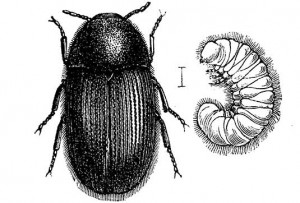DSB is a pharmaceutical feeder of consumables.
⦁ Aliases: DSB, biscuit beetle, bread beetle (paniceum means “made from bread” in Latin).
⦁ Description: Adults are 1/10- to 1/7-in. long and tubular. Generally brown in color, adults have rows of hairs running the length of the wing covers. Antennae end in a three-segmented club. Larvae are small, white and scarab-shaped during later instars.
⦁ Life cycle: Complete metamorphosis. The adult female lives 13 to 65 days. Based on the appropriate environmental cues and nutrients, she places 20 to 100 eggs. Larvation is four to 20 weeks. Pupation is 12 to 18 days. Depending on heat and nutrition, the life cycle can take less than two months or as long as seven.
⦁ Habitat: Highly adaptable and variant upon food sources, almost any human habitat can serve as host to populations. DSB can be found in bird nests, inside books and wooden items, and even bore into aluminium foil or lead.
⦁ Food: With a pattern of feeding on prescription drugs, DSB infests and consumes flour, baked goods, candies, spices, animal fibers, hair, leather, museum specimens and more. The larval stage is the most destructive.
⦁ Range: Found globally.
⦁ Unique behavior: With symbiotic yeasts producing a vitamin B complex, DSB adults place yeasts on eggs during oviposition. Larvae consume the yeast during emergence from eggs. Yeast symbionts provide DSB with the ability to survive on foods of poor nutritional content.
⦁ Significance: With an ability to survive on numerous food sources, DSB is a threat to drug production facilities, as well as to field-to-fork food production. Infestations can occur, and can even be common, within processed and packaged human and pet foods.
Dr. Stuart Mitchell, D.O., Ph.D., M.P.H., B.C.E., a board-certified physician and entomologist, is principal technical specialist for PestWest Environmental, as well as PMP’s Technical Editor. He can be reached at docmitchell@northcoastmedia.net or 515-333-8923.

Leave A Comment